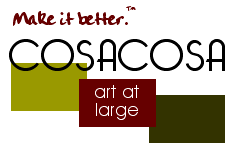



into a genuine dialogue with each other. In a genuine dialogue each of the partners,
even when he stands in opposition to the other, heeds, affirms, and confirms his opponent
as an existing other.“
-Martin Buber, Genuine Dialogue and the Possibilities of Peace
Art is usually seen as a form of personal expression. But it is also, and fundamentally, a means of communication. In a complex world, it can offer a virtual space where different, even conflicting perspectives can coexist, and where previously unimagined harmonies can emerge. Particularly since the 1960's, many artists have been moved to take art off its cultural pedestal, and to make work that engaged audiences in direct dialogue, through guerrilla theater and other provocative forms. Existing for more than personal expression, work like this was meant to bring people to new insights that would make social change possible.
New, open-ended art forms could combine searching dialogue and ritual-like public events. Suzanne Lacy, for example, has made large-scale works of public performance art, aimed at empowering disenfranchised people and bringing their concerns into the civic arena. An early work of hers, Take Back the Night (1978), culminated in a parade of women during a conference on pornography in San Francisco. A number of Lacy’s works have incorporated community dialogue events, including The Turning Point/Under Construction (1997-98), highlighting the voices of teenage girls, many of them immigrants, in Vancouver.
Another artist exemplifying this loosely-structured, communication-rich approach is choreographer Liz Lerman. Her Shipyard Project (1994-96) involved a wide spectrum of the New Hampshire community of Portsmouth. Group explorations through dance and talk sessions led to performance events that helped to air issues of unemployment, toxic waste and racism. In visual art, the pioneering Helen Mayer and Newton Harrison have created deeply-researched works that help communities see themselves and collectively contemplate major environmental issues.
In theater, Anna Deavere Smith created a powerful approach, listening to and then animating the voices of people on many sides of explosive situations, in her solo works Fires in the Mirror: Crown Heights, Brooklyn and other Identities, and Twilight: Los Angeles, 1992. In these works, equal voice was given to children and older people, black and white, Christian and Jewish. Artists like these have been recognized as making a special contribution to the larger culture. The Animating Democracy initiative aims to highlight and encourage such work, and analyze what can enhance its effectiveness.
Inspired by a production of Deavere Smith’s Fires in the Mirror, COSACOSA Youth Council member Lee Fogel sought out and interviewed people on all sides of the Israeli-Palestinian conflict, in the U.S. and Israel. Each person was asked how they felt about the possibilities of dialogue in helping to move toward a resolution of this intractable impasse. The monologues she crafted from these interviews were first performed as a play at Fogel’s high school. The piece allows us to hear the personal stories and concerns of people who might not speak as candidly were they in the same room.
In the past year, COSACOSA added another layer to this rich material: teens from the North Philadelphia worked with Fogel on a curriculum to explore similarities among interpersonal hostilities, gang violence, neighborhood strife, and racism in Philadelphia and the Israeli-Palestinian conflict abroad. Listening to voices talking about a faraway but intense conflict, and reworking the material themselves, COSACOSA youth initiated their own creative process about and activated by dialogue. As an introduction to the enclosed audio version of the piece, the teens distilled and recorded a collage of statements about dialogue taken from the monologues: a ”conversation“ further integrating the thoughts, emotions and ideals of the original speakers, past performers, and the North Philadelphia community.
This work, Listening for Dialogue, now including the contributions of dozens of people of extremely varied backgrounds, can be seen as a kind of meta-artwork, both involving dialogue and taking dialogue as its subject. In this, it adds to and echoes not only related dialogue-based art, but the philosophical premises of this kind of work, which go back at least to the philosopher Martin Buber. In his pioneering book I and Thou, Buber affirmed the central importance of communion between two beings, based on authentic listening and acknowledgment of the other’s living presence. Buber’s writings have inspired approaches to aesthetic theory that attempt to place dialogue at the center of the artistic experience as well. Buber’s personal engagement with these issues offers a strange parallel to Listening for Dialogue. In Israel, where he moved from Germany in 1938, Buber became a maverick who insisted on the rights of Arabs in the new state of Israel. He created an organization (Brit Shalom, A Covenant for Peace) advocating a bi-national state with full equality for Israelis and Palestinian Arabs, and continued to urge for genuine dialogue among them until his death.
Listening for Dialogue reminds us that, in a world of intractable violence, listening and sharing views offers an antidote to despair. The project continues to grow past its initial intentions; who knows what the next elaboration of Listening for Dialogue will be? Who knows what new insights have been touched off in people’s minds and hearts, that may point a way toward peace?
Miriam Seidel is a corresponding editor for Art in America.
Download a pdf copy of the complete Listening for Dialogue catalogue ![]()
To order a copy of the Listening for Dialogue catalogue and CD, please contact COSACOSA.